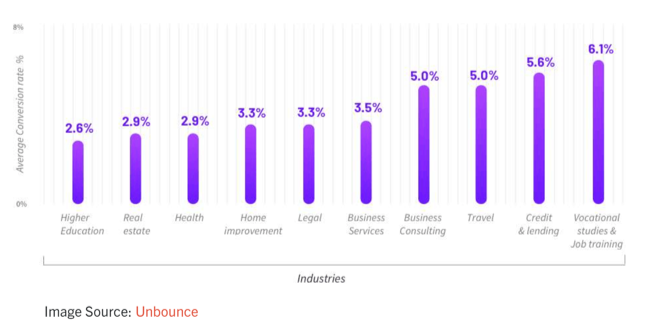Clicks, Impressions & Conversions: 11 Digital Marketing Terms You Need to Know in 2021
DMS Insights published an article sharing the projected advertising spend for digital advertising to account for 53% of total ad spend. Despite Coronavirus causing a decrease in ad spending across all channels, digital is still expected to garner a large portion of advertising budgets.
Digital marketing can be an awesome way to advertise, but before you dive in, you need to know some of the key terms.

Here are the 10 most important digital marketing terms to know in 2021
1. Landing Pages
This is probably the most overlooked part of digital marketing. The landing page is where the user goes after they click your ad. If you’re sending clicks right to your homepage, you’re probably missing out on a big opportunity.
The landing page should be related to the ad that clicks to it. Users expect customization, if your ad compels them to click your landing page should make the next step of the purchase process clear and simple to execute. For example, if your ad talks about different types of shoes you sell, the landing page should display different types of shoes.
The simple act of making your landing page relate to your ad copy can increase your digital marketing success greatly.
When you are evaluating the success of your landing pages you should measure conversions from the page. We’ll dive into further detail on conversions in a bit.
According to HubSpot, a good landing page conversion rate is percent.
2. PPC (Pay Per Click)
Pay per click advertising is what the name suggests. It’s a method of payment for digital marketing where the advertiser pays for the action of a click on an advertisement. This pricing model is common for paid search campaigns through Google Ads, Bing and also on Facebook. Crafting compelling ads, that entice a user to take action, can generate a lot of traffic to your website. The key is finding a balance, knowing what your goals are and continually measuring your progress. Most pay per click is based on bidding, meaning you set a maximum cost per click. Knowing your industry and doing your research can help you to ensure your budget and your goals are aligned for success.
One of the primary benefits of PPC advertising is that you only pay when your ad is clicked. Every time your ad is shown (served an impression) is free. You're essentially promoting your brand for free until someone clicks, and there is certainly intrinsic value in having your brand visible to consumers.
3. Conversions
A conversion that happens after a click, is often an indicator of intent. The journey would go something like this: 1.) You create a compelling PPC 2). A user clicks thru to your website 3.) Your landing page provides the information they seek. 4.) The user takes the next step toward purchasing, after they have landed on your website or your Social Media page some examples of conversion might be:
- Filling out a form
- Downloading an eBook or case study
- Making an online purchase
- Clicking for directions to your location
4. Conversion Rate
This is measured as a percentage of visitors to your website or a landing page that complete a conversion. The formula for calculation is: Form Submissions + Tracked Calls / Total Website or Landing Page Visitors = Conversion Rate. When you set out to evaluate your conversation rate performance be sure to compare yourself to your industry. As you can see based on research from Unbounce there is a big variance in average conversion rate by industry. Your goal should be to be at the high end of your industries average.

5. Programmatic Advertising
This is a process of display ad buying in which Artificial Intelligence is used to automate. This method of ad buying allows for sophisticated targeting. According to eMarketer, 86.5% of digital display ads in the U.S. will be sold programmatically in 2020.
Our sister company, Leighton Engage, specializes in programmatic advertising. They're able to place digital ads to users searching for or reading about your products and services. These tactics are called search and keyword contextual targeting, respectively.
Here's what that could look like.
Let's say you're a local jewelry store looking to promote your new line of men's watches. Logic dictates that your ads should target men who are into masculine activities, like sports, fishing, and trucks and blanket the ads to those users. While this can be effective, the ads will inevitably reach men who just aren't looking to buy a watch, nor may ever buy one. It also leaves out the women in their lives (wives, mothers, daughters) who might be looking to purchase a watch as a gift.

With programmatic advertising and keyword contextual targeting, rather than targeting a general group of users who might be interested in a product or service, we're able to target individual users who are specifically interested and perhaps ready to buy.
Programmatic even allows for hyper-local geofencing campaigns. That's a fancy way of saying we can target users at a specific location using the GPS on their smartphone. We're able to quite literally draw a line around a place of business and build an audience of users who enter, then serve ads to them.
It doesn't have to be your business either. Imagine fencing your competitors and serving ads to their patrons after they've left. We can even report on the number of users who visited any defined location and then visited your location. This is called a foot-traffic conversion and it's invaluable for brick and mortar businesses.
All of this is possible with programmatic adverting.
6. Interactive Content
Interactive Content was one of the seven Marketing Trends to Consider in 2020 by Chief Marketer. Users crave engaging content that is relevant, timely and entertaining. Rather than passive content requiring an audience to read or watch a video, interactive content engages them making part of the process of learning more. Some examples include:
- Calculators
- Quizzes
- Polls
- 360 degree tours
7. KPIs (Key Performance Indicators)
The foundation of a great digital marketing campaign is creating a strategy with clear SMART (Specific, Measurable, Achievable, Relevant, Timely) goals. Digital marketing KPIs are benchmarks to track your progress toward your goals. Keep in mind they should be channel specific.
For example, on Social Media, you might want more followers to become customers (relevant). So, this month (time-bound), you want to increase your organic post engagement (specific) from 4.5% to 5.5% per month average (measurable) which you will do by posting more interactive content links to our website landing pages designed to convert (achievable).
For Email, your KPIs might be more focused on delivery rates, open rates, click through rate and conversions. Make sure you have a SMART framework in place and that the KPIs are measuring activity and actions that will help you achieve desired business goals like revenue growth.
8. Cost Per Thousand (CPM)
Not only is this a pricing model for digital advertising, it is also a reporting metric. The Cost per Thousand refers to impressions. Many digital advertising company’s rates are based on a CPM. For example, you could buy 10,000 impressions at a $5.00 CPM and it would cost $50.00.
I’ve seen some companies ask for outrageous CPM amounts. If you’re entertaining a proposal that includes CPM rate, here are some guidelines for what is fair for each ad type:
- Video Pre-Roll:$25–$45/CPM – Based on length of ad and whether it can be skipped.
- Display Ads:$5–$25/CPM – Based on size of the ad and position on the website. Small ads at the bottom of a site are not worth as much as a large ad at the top of the site.
- Mobile Specific Ads:$10–$30/CPM – Based on ad size and position on the site. Also based on targeting options (discussed below).
- OTT/Connected TV Ads: $30–$50/CPM – Based on targeting and placement.
- Social Media Ads: $5–$15/CPM - Based on the social network and targeting options for the ads.
There are many more ad types out there, but those are the most common and should give you a good basis to work with.
9. click-Through Rate (CTR)
This is the percentage of people who clicked your ad from the total impressions. For example, if you had 10,000 impressions and 100 clicks, your CTR is 1%. For display ads, a 0.6% CTR is average. For Google Search Ads, 3% or so is pretty good, for Facebook .9% is the average across all industries.
However…
Your CTR depends on many factors, but most of them you can control. One factor that can have a big effect on click-through rate is the ad creative, i.e. what your ad looks like will play a big part of whether or not users decide to click.
10. ROI & ROAS
These stand for Return on Investment and Return on Ad Spend. For the purposes of this post, they're essentially the same thing. ROI is a metric for any marketing investment, whereas ROAS is specifically for digital advertising.
Calculating ROAS is a simple formula:
Revenue Generated by Ad Spend / Total Ad Spend
Advertisers can calculate Return on Ad Spend at any level of their digital advertising engagement—at the campaign level, ad set level, or even for each individual ad in a campaign. Since digital advertising is able to track performance at every level, one can see how each ad they're running has impacted the bottom line.
Clearly, it can be easy to get into the weeds and spend more time than needed permutating every possible result.
The key caveat here is that Return on Ad Spend requires some sort of transaction tied directly to an ad click, like a product purchase or event registration.
Campaigns meant for driving awareness, or promoting a certain offer are not good candidate for measuring ROAS.
11. Marketing Automation
A software designed to automate marketing tasks. Common brands of automation software include: Constant Contact (email and social), HubSpot (CRM, CMS, Email and Social).
Marketing Automation creates efficiencies in marketing tasks, and helps streamline customization. For example, an online clothing boutique might use marketing automation software to automate emails based on actions users take on their site.
If a user fills a cart with items, but does not complete the transaction, marketing automation software can be used to send an email reminder to the user that their cart is waiting. Using technology like this to personalize engagements and automate the process allows markets to focus on strategy and planning while execution of tasks can be completed with the help of software.
Digital Marketing Terms Recap
As the Executive Director of Digital at Leighton Media, I love to talk digital advertising, and educate people about how to buy digital efficiently. If you still have questions after reading this blog, we’re here to help! Reach out with any digital marketing questions you may have.


